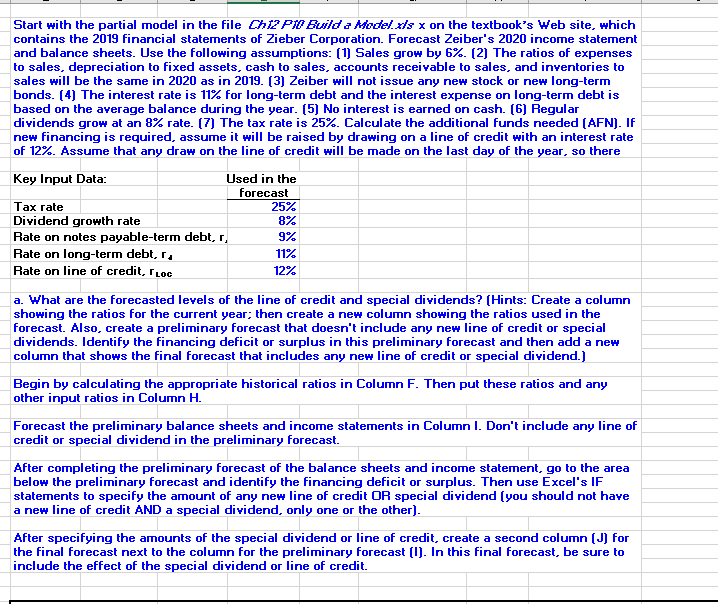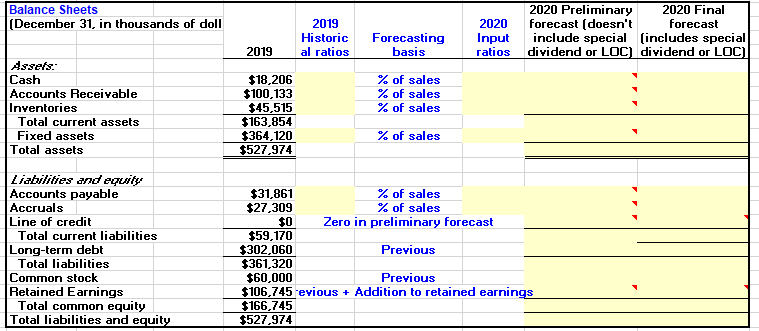

Start with the partial model in the file Chi2 P10 Build a Model xls x on the textbook's Web site, which contains the 2019 financial statements of Zieber Corporation. Forecast Zeiber's 2020 income statement and balance sheets. Use the following assumptions: (1) Sales grow by 6%. (2) The ratios of expenses to sales, depreciation to fixed assets, cash to sales, accounts receivable to sales, and inventories to sales will be the same in 2020 as in 2019. (3) Zeiber will not issue any new stock or new long-term bonds. (4) The interest rate is 11% for long-term debt and the interest expense on long-term debt is based on the average balance during the year. (5) No interest is earned on cash. (6) Regular dividends grow at an 8% rate. (7) The tax rate is 25%. Calculate the additional funds needed (AFN). IF new financing is required, assume it will be raised by drawing on a line of credit with an interest rate of 12%. Assume that any draw on the line of credit will be made on the last day of the year, so there Key Input Data: Used in the forecast Tax rate 25% Dividend growth rate 8% Rate on notes payable-term debt,r, 9% Rate on long-term debt, 11% Rate on line of credit, Cloc 12% a. What are the forecasted levels of the line of credit and special dividends? (Hints: Create a column showing the ratios for the current year; then create a new column showing the ratios used in the forecast. Also, create a preliminary forecast that doesn't include any new line of credit or special dividends. Identify the financing deficit or surplus in this preliminary forecast and then add a new column that shows the final forecast that includes any new line of credit or special dividend.) Begin by calculating the appropriate historical ratios in Column F. Then put these ratios and any other input ratios in Column H. Forecast the preliminary balance sheets and income statements in Column I. Don't include any line of credit or special dividend in the preliminary forecast. After completing the preliminary forecast of the balance sheets and income statement, go to the area below the preliminary forecast and identify the financing deficit or surplus. Then use Excel's IF statements to specify the amount of any new line of credit OR special dividend (you should not have a new line of credit AND a special dividend, only one or the other). After specifying the amounts of the special dividend or line of credit, create a second column (J) for the final forecast next to the column for the preliminary forecast (I). In this final forecast, be sure to include the effect of the special dividend or line of credit. Balance Sheets (December 31, in thousands of doll 2019 Historic al ratios Forecasting basis 2020 Input ratios 2020 Preliminary 2020 Final forecast (doesn't forecast include special (includes special dividend or LOC) dividend or LOC) 2019 Assels: Cash Accounts Receivable Inventories Total current assets Fixed assets Total assets $18,206 $100,133 $45,515 $163,854 $364,120 $527,974 % of sales % of sales % of sales % of sales Liabilities and equity Accounts payable Accruals Line of credit Total current liabilities Long-term debt Total liabilities Common stock Retained Earnings Total common equity Total liabilities and equity $31,861 % of sales $27,309 % of sales $0 Zero in preliminary forecast $59,170 $302,060 Previous $361,320 $60,000 Previous $106,745 evious + Addition to retained earnings $166,745 $527,974 Start with the partial model in the file Chi2 P10 Build a Model xls x on the textbook's Web site, which contains the 2019 financial statements of Zieber Corporation. Forecast Zeiber's 2020 income statement and balance sheets. Use the following assumptions: (1) Sales grow by 6%. (2) The ratios of expenses to sales, depreciation to fixed assets, cash to sales, accounts receivable to sales, and inventories to sales will be the same in 2020 as in 2019. (3) Zeiber will not issue any new stock or new long-term bonds. (4) The interest rate is 11% for long-term debt and the interest expense on long-term debt is based on the average balance during the year. (5) No interest is earned on cash. (6) Regular dividends grow at an 8% rate. (7) The tax rate is 25%. Calculate the additional funds needed (AFN). IF new financing is required, assume it will be raised by drawing on a line of credit with an interest rate of 12%. Assume that any draw on the line of credit will be made on the last day of the year, so there Key Input Data: Used in the forecast Tax rate 25% Dividend growth rate 8% Rate on notes payable-term debt,r, 9% Rate on long-term debt, 11% Rate on line of credit, Cloc 12% a. What are the forecasted levels of the line of credit and special dividends? (Hints: Create a column showing the ratios for the current year; then create a new column showing the ratios used in the forecast. Also, create a preliminary forecast that doesn't include any new line of credit or special dividends. Identify the financing deficit or surplus in this preliminary forecast and then add a new column that shows the final forecast that includes any new line of credit or special dividend.) Begin by calculating the appropriate historical ratios in Column F. Then put these ratios and any other input ratios in Column H. Forecast the preliminary balance sheets and income statements in Column I. Don't include any line of credit or special dividend in the preliminary forecast. After completing the preliminary forecast of the balance sheets and income statement, go to the area below the preliminary forecast and identify the financing deficit or surplus. Then use Excel's IF statements to specify the amount of any new line of credit OR special dividend (you should not have a new line of credit AND a special dividend, only one or the other). After specifying the amounts of the special dividend or line of credit, create a second column (J) for the final forecast next to the column for the preliminary forecast (I). In this final forecast, be sure to include the effect of the special dividend or line of credit. Balance Sheets (December 31, in thousands of doll 2019 Historic al ratios Forecasting basis 2020 Input ratios 2020 Preliminary 2020 Final forecast (doesn't forecast include special (includes special dividend or LOC) dividend or LOC) 2019 Assels: Cash Accounts Receivable Inventories Total current assets Fixed assets Total assets $18,206 $100,133 $45,515 $163,854 $364,120 $527,974 % of sales % of sales % of sales % of sales Liabilities and equity Accounts payable Accruals Line of credit Total current liabilities Long-term debt Total liabilities Common stock Retained Earnings Total common equity Total liabilities and equity $31,861 % of sales $27,309 % of sales $0 Zero in preliminary forecast $59,170 $302,060 Previous $361,320 $60,000 Previous $106,745 evious + Addition to retained earnings $166,745 $527,974








